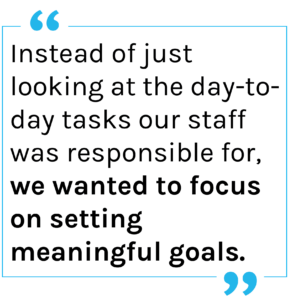Effective performance management is key to employee retention and growth.
The best performance management programs actively keep employees engaged and help them have an impact on their workplace. Over the years, our customers have come with some key aspects to performance management for HigherEd employees. Check out their recommendations below!
Build consistency across campus
At Appalachian State University—an institution that is part of the University of North Carolina multi-campus system—the human resources team decided to work with PeopleAdmin to implement a new performance management system and, in the process, realized they could lead the charge for consistent process across the UNC system.
“Once all the professional development coordinators across the university system came together to discuss the initiative, we realized how vastly different all of our processes and systems were,” said Emily Wilson, Professional Development Coordinator for App State. “It was interesting to see how far ahead our university’s technology was.”
Creating consistent processes across campuses—or even just across departments and colleges—is key to ensure clear guidelines and standardized reviews, which helps ensure that everyone participates in the process and understands expectations.
Frame conversations around development and goals
Emily also spoke about the type of review that App State decided to emphasize. To really focus on employee improvement and development, they wanted to do more than just check the box of “performance reviews.”
 “We wanted to look at Performance Management at a higher level,” Emily said. “Instead of just looking at the day-to-day tasks our staff was responsible for, we wanted to focus on setting meaningful goals. [Make] it easy to enter comments and ratings, and giving supervisors the option to do so during or after conversations. This reinforces that feedback is important and that it’s all about success, not just documentation.”
“We wanted to look at Performance Management at a higher level,” Emily said. “Instead of just looking at the day-to-day tasks our staff was responsible for, we wanted to focus on setting meaningful goals. [Make] it easy to enter comments and ratings, and giving supervisors the option to do so during or after conversations. This reinforces that feedback is important and that it’s all about success, not just documentation.”
At Indiana University in Bloomington, the HR department had similar thoughts about their performance management process—emphasizing that employees are participating in a conversation about their goals and development, instead of filling out forms for a required process.
“The most effective evaluations happen when an employee feels free to talk,” said John Whelan, Associate Vice President and Chief Human Resources Officer at IU. “The second documentation starts, people put up barriers. Everybody is afraid of what it’s going to look like on paper as opposed to opening up about what they’re doing well and what they need. There’s a human emotional component that the more structured it gets, the less open employees are.”
Go digital
All of these best practices are easy to implement once you’ve launched a digital performance management system like PeopleAdmin’s. Eliminate paper forms, give HR easy visibility, create efficient workflows, and keep consistent historical records with our configurable system. Reach out to our experts for a demo!